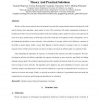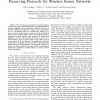346 search results - page 35 / 70 » Redundant Coverage in Wireless Sensor Networks |
AINA
2007
IEEE
13 years 12 months ago
2007
IEEE
Abstract--Monitoring and automatic control of building environment is a crucial application of Wireless Sensor Network (WSN) in which maximizing network lifetime is a key challenge...
AICCSA
2006
IEEE
14 years 2 months ago
2006
IEEE
Collaborative signal processing is one of the most promising applications that are currently being investigated for sensor networks. In this paper, we use FFT computation as a veh...
IJSNET
2006
13 years 7 months ago
2006
: In this paper, we present a two-tiered scheduling approach for effective energy conservation in wireless sensor networks. The effectiveness of this mechanism relies on dynamicall...
WINET
2002
13 years 7 months ago
2002
Wireless ad-hoc sensor networks have the potential to provide the missing interface between the physical world and the Internet, thus impacting a large number of users. This conne...
ISCAS
2005
IEEE
14 years 1 months ago
2005
IEEE
Abstract— The wireless sensor network is an emerging technology that may greatly facilitate human life by providing ubiquitous sensing, computing, and communication capability. H...


